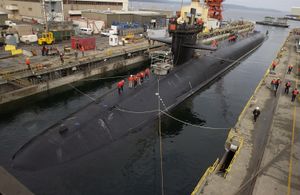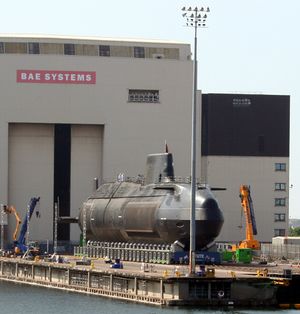غواصة نووية
الغواصة النووية ، هي غواصة تعمل عن طريق تقنية المفاعل النووي، بالمقارنة بالغواصات التقليدية والتي تعمل عن طريق محركات الديزل حيث تستخدم لشحن البطاريات للتشغيل تحت الماء. ويتسع مجال الغواصات النووية حيث تستخدم في مهمات الدفع النووي، في أجواء مستقلة تماما عن الهواء بعكس الغواصات العادية والتي تحتاج للسطح، حيث أن كمية الطاقة النووية المولدة لتلك الغواصات تسمح لها بالعمل بسرعات عالية لفترات طويلة تحت سطح الماء; والفاصل الزمني الطويل بين فترات إعادة التموين منح مجموعة محدودة فقط من المواد الاستهلاكية مثل المواد الغذائية - الأجيال الحالية من الغواصات النووية لا تحتاج إلى التزود بالوقود في جميع فترات أعمارهم ال 25-عاما.[1]وعلى العكس، فإن الطاقة المخزنة في البطاريات محدودة الكهربائية يعني أنه حتى الأكثر تقدما فإن الغواصة التقليدية يمكنها أن تبقى مغمورة فقط لبضعة أيام في الماء بسرعة بطيئة ، وبضع ساعات فقط في سرعة قصوى؛ التطورات الحديثة في الهواء ومستقلة الدفع قد تآكلت هذه الميزة إلى حد ما. ارتفاع تكلفة التكنولوجيا النووية يعني أن دولا قليلة نسبيا وقد أوفد الغواصات النووية.
التاريخ
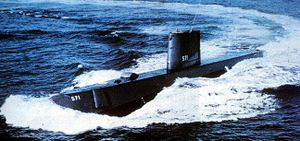
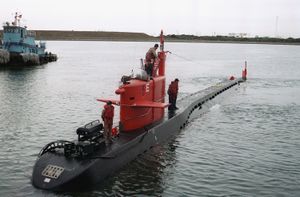
في عام 1954، أدخلت البحرية الأمريكية في خدمتها الفعلية أول غواصة تعمل بالقدرة النووية، وأُطلق عليها اسم نوتيلوس. وفي أول رحلة بحرية لها، حطمت تلك الغواصة كل الأرقام القياسية السابقة لسرعة سير الغواصات تحت المياه، ودرجة تحملها. وفي عام 1958م، أصبحت الغواصة نوتيلوس أول غواصة تَبْحر تحت ثلوج القطب الشمالي. وفي عام 1960م كانت الغواصة الامريكية تريتون أول غواصة تُسافر حول العالم تحت المياه.
طوَّرت البحرية الأمريكية في أوائل الستينيات من القرن العشرين أول غواصات حديثة لإطلاق الصواريخ البالستية، وكانت كل غواصة منها تحمل 16 صاروخًا من صواريخ بولاريس، وتحمل أسلحة نووية خلف الشراع. وكان بإمكان الطراز الأول لصواريخ پولاريس أن تضْرب أهدافًا تصل إلى بُعد 1930 كم. وقد طُورت هذه الصواريخ فيما بعد ليزداد إصابتها إلى 4,500كم.
دخلت أول غواصة نووية في الخدمة الفعلية للبحرية البريطانية في 1963، وهي الغواصة إتش إم إس دريد نوت. أما الطراز الأكثر تطورًا منها وهو الغواصة إتش إم إس رزوليوشن، التي حملت أول صاروخ بولاريس نووي، فقد دخلت الخدمة في عام 1967.
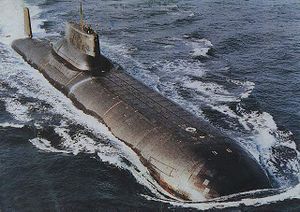
وفي عام 1981، صنعت الولايات المتحدة أول جيل من الغواصات أوهايو. وتُعتبر تلك الغواصات أكبر وأقوى الغواصات التي بنتها الولايات المتحدة حتي الآن، حيث تبلغ 170 مترًا طولاً وتحمل 24 من صواريخ ترايدنت، يبلغ مدى كل صاروخ منها حوالي 6,400كم. ويمكن أن يحتوي على عدة رؤوس نووية مستقلة يمكن توجيه كل منها إلى هدف مُنْفصل. وتُخطط الحكومة البريطانية لإحلال صواريخ ترايدنت محل صواريخ بولاريس في التسعينات من القرن العشرين.
وقبل تفككه في عام 1991 كان الاتحاد السوڤيتي يمتلك أكبر غواصات الصواريخ البالستية حجمًا. وكانت صواريخ تلك الغواصات تضرب أهدافًا على بعد يصل إلى 8,000 كم. وامتلك الاتحاد السوفييتي أيضًا أسطولاً من الغواصات النووية ـ 310 غواصة ـ زاد عددها على أي دولة أخرى، وتلتها الولايات المتحدة. وفي عام 1992، دشـّنت روسيا، وتبعتها أوكرانيا، أسطولها من الغواصات. وقد ضمت روسيا معظم الغواصات التي كان يمتلكها الاتحاد السوفيتي السابق. ومن الدول الأخرى التي تمتلك الغواصات النووية الصين وفرنسا وبريطانيا.
وكانت البحرية الملكية لبريطانيا أول بحرية في العالم تستخدم الغواصات النووية في القتال عندما استخدمتها أثناء الصراع بين بريطانيا والأرجنتين حول جزر فوكلاند عام 1982. [3]
التقنية
The main difference between conventional submarines and nuclear submarines is the power generation system. Nuclear submarines employ nuclear reactors for this task. They either generate electricity that powers electric motors connected to the propeller shaft or rely on the reactor heat to produce steam that drives steam turbines (cf. nuclear marine propulsion). Reactors used in submarines typically use highly enriched fuel (often greater than 20%) to enable them to deliver a large amount of power from a smaller reactor and operate longer between refuelings – which are difficult due to the reactor's position within the submarine's pressure hull.
The nuclear reactor also supplies power to the submarine's other subsystems, such as for maintenance of air quality, fresh water production by distilling salt water from the ocean, temperature regulation, etc. All naval nuclear reactors currently in use are operated with diesel generators as a backup power system. These engines are able to provide emergency electrical power for reactor decay heat removal, as well as enough electric power to supply an emergency propulsion mechanism. Submarines may carry nuclear fuel for up to 30 years of operation. The only resource that limits the time underwater is the food supply for the crew and maintenance of the vessel.
The stealth technology weakness of nuclear submarines is the need to cool the reactor even when the submarine is not moving; about 70% of the reactor output heat is dissipated into the sea water. This leaves a "thermal wake", a plume of warm water of lower density which ascends to the sea surface and creates a "thermal scar" that is observable by thermal imaging systems, e.g., FLIR.[5] Another problem is that the reactor is always running, creating steam noise, which can be heard on SONAR, and the reactor pump (used to circulate reactor coolant), also creates noise, as opposed to a conventional submarine, which can move about on almost silent electric motors.[بحاجة لمصدر]
تطور ونـَسب
البحرية الأمريكية
مرفوعة من الخدمة
- SCB-64: يوإسإس Nautilus (SSN-571)
- SCB-64A: يوإسإس Seawolf (SSN-575)
- SCB-121: Skate-class attack submarines
- SCB-132: يوإسإس Triton (SSRN-586)
- SCB-137A: يوإسإس Halibut (SSGN-587)
- SCB-154: Skipjack-class attack submarines
- SCB-178: يوإسإس Tullibee (SSN-597)
- SCB-180A: George Washington-class ballistic missile submarines
- SCB-180: Ethan Allen-class ballistic missile submarines
- SCB-188: Permit-class attack submarines
- SCB-188A: Sturgeon-class attack submarines
- SCB-216: Lafayette-class ballistic missile submarines
- SCB-216: James Madison-class ballistic missile submarines
- SCB-216: Benjamin Franklin-class ballistic missile submarines
- NR-1
- SCB-245: يوإسإس Narwhal (SSN-671)
- SCB-302: يوإسإس Glenard P. Lipscomb (SSN-685)
شغالة
- SCB-303: Los Angeles-class attack submarines
- SCB-304: Ohio، طراز ballistic missile submarines
- Seawolf-class attack submarines
- Virginia-class attack submarines
قيد الإنشاء
- Columbia-class submarine (قيد الإنشاء)
البحرية السوڤيتية/الروسية
مرفوعة من الخدمة
- Project 627 (November) attack submarines
- Project 645 test attack submarine K-27
- Project 658 (Hotel) ballistic missile submarines
- Project 659/675 (Echo) cruise missile submarines
- Project 661 (Papa) attack submarines
- Project 667 (Yankee) ballistic missile submarines
- Project 667B, Murena (Delta I) ballistic missile submarines
- Project 667BD, Murena-M (Delta II) ballistic missile submarines
- Project 670 (Charlie) cruise missile submarines
- Project 671 (Victor) attack submarines
- Project 678 (X-Ray) research submersible
- Project 685 (Mike) attack submarine K-278 Komsomolets
- Project 705 (Alfa) attack submarines
Operational submarines
- Project 667BDR, Kalmar (Delta III) ballistic missile submarines
- Project 667BDRM, Delfin (Delta IV) ballistic missile submarines
- Project 671RTM Shchuka (Victor III) attack submarines
- Project 885 (Yasen) attack submarines
- Project 935 (Borei) ballistic missile submarines
- Project 941 (Typhoon) ballistic missile submarines
- Project 945 (Sierra) attack submarines
- Project 949 (Oscar) cruise missile submarines
- Project 971 (Akula) attack submarines
- Project 1851.1 (Paltus) special purpose submarines
- Project 1910 Kashalot-class (Uniform) special purpose submarines
- Project 1983.1 AS-12 (Losharik) special purpose submarine
قيد الإنشاء
البحرية الملكية
مرفوعة من الخدمة
- إتشإمإس Dreadnought (S101)
- Valiant-class attack submarines
- Resolution-class ballistic missile submarines
- Churchill-class attack submarines
- Swiftsure-class attack submarines
شغالة
- Trafalgar-class attack submarines
- Vanguard-class ballistic missile submarines
- Astute-class attack submarines
قيد الإنشاء
- Dreadnought-class ballistic missile submarines (قيد الإنشاء)
البحرية الفرنسية
مرفوعة من الخدمة
شغالة
قيد التطوير
- Barracuda-class attack submarines (In development, first delivery: the Suffren on July 12th 2019)
- SNLE 3G-class ballistic missile submarines - 4 planned.[6]
بحرية جيش التحرير الشعبي الصيني
شغالة
- Type 091 (Han) attack submarines
- Type 092 (Xia) ballistic missile submarines
- Type 093 (Shang) attack submarines
- Type 094 (Jin) ballistic missile submarines
قيد التطوير
- Type 095 attack submarines (قيد التطوير)
- Type 096 (Tang) ballistic missile submarines (قيد التطوير)
البحرية الهندية
مرفوعة من الخدمة
- INS Chakra leased Soviet Charlie-class submarine commissioned between 1987 – 1991.
شغالة
- INS Chakra leased Russian Akula-class attack submarine, named after the previous INS Chakra
- Arihant، طراز submarine آيإنإس Arihant commissioned in August 2016 in the Indian Navy.
قيد التطوير
- Arihant، طراز submarine – INS Arighat and two more boats under construction. To be followed by larger boats capable of carrying 12–16 ballistic missiles.[7](Under Construction)
- Indian Navy SSN programme – 6 submarines to be built.[8] (Under Development)
- INS Chakra - $3 Billion contract signed to lease 1 Akula class Submarine from Russia to be delivered by 2025[9][10]
- S5 Class– A large planned follow on class of Arihant Class Submarines- 3 submarines to be built (Under Development)[11][12][13]
البحرية البرازيلية
قيد التطوير
- Álvaro Alberto-class submarine (قيد التطوير)
الحوادث
Reactor accidents
Some of the most serious nuclear and radiation accidents by death toll in the world have involved nuclear submarine mishaps. To date, all of these were units of the former Soviet Union.[14][15][16] Reactor accidents that resulted in core damage and release of radioactivity from nuclear-powered submarines include:[14][17]
- K-8, 1960: suffered a loss-of-coolant accident; substantial radioactivity released.[18]
- K-14, 1961: the reactor compartment was replaced due to unspecified "breakdown of reactor protection systems".
- K-19, 1961: suffered a loss-of-coolant accident resulting in 8 deaths and more than 30 other people being over-exposed to radiation.[19] The events on board the submarine are dramatized by the film K-19: The Widowmaker.
- K-11, 1965: both reactors were damaged during refueling while lifting the reactor vessel heads; reactor compartments scuttled off the east coast of Novaya Zemlya in the Kara Sea in 1966.
- K-27, 1968: experienced reactor core damage to one of its liquid metal (lead-bismuth) cooled VT-1 reactors, resulting in 9 fatalities and 83 other injuries; scuttled in the Kara Sea in 1982.[14]
- K-140, 1968: the reactor was damaged following an uncontrolled, automatic increase in power during shipyard work.[20]
- K-429, 1970: an uncontrolled start-up of the ship's reactor led to a fire and the release of radioactivity[20]
- K-116, 1970: suffered a loss-of-coolant accident in the port reactor; substantial radioactivity released.
- K-64, 1972: the first Alfa-class liquid-metal cooled reactor failed; reactor compartment scrapped.
- K-222, 1980: the Papa-class submarine had a reactor accident during maintenance in the shipyard while the ship's naval crew had left for lunch.[20]
- K-123, 1982: the Alfa-class submarine reactor core damaged by liquid-metal coolant leak; the sub was forced out of commission for eight years.[20][21]
- K-431, 1985: a reactor accident while refueling resulted in 10 fatalities and 49 other people suffered radiation injuries.[15]
- K-219, 1986: suffered an explosion and fire in a missile tube, eventually leading to a reactor accident; a 20-year-old enlisted seaman, Sergei Preminin, sacrificed his life to secure one of the onboard reactors. The submarine sank three days later.
- K-192, 1989 (reclassified from K-131): suffered a loss-of-coolant accident due to a break in the starboard reactor loop.
عرق وحوادث رئيسية أخرى
- يوإسإس Thresher (SSN-593), 1963: was lost during deep diving tests with 129 crew and shipyard personnel on board; later investigation concluded that failure of a brazed pipe joint and ice formation in the ballast blow valves prevented surfacing. The accident motivated a number of safety changes to the U.S. fleet. Thresher was the first of only two submarines to exceed 100 onboard deaths, joined by the Russian Kursk's 118 lost in 2000.
- K-3, 1967: the first Soviet nuclear submarine experienced a fire associated with the hydraulic system, killing 39 sailors.
- يوإسإس Scorpion (SSN-589), 1968: was lost at sea, evidently due to implosion upon sinking. What caused Scorpion to descend to its crush depth is not known.
- يوإسإس Guitarro (SSN-665), 1969: sank while pier-side in shipyard due to improper ballasting. The submarine was eventually completed and commissioned.
- K-8, 1970: a fire and a towing accident resulted in the boat's sinking and loss of all 52 crewmen remaining aboard.
- K-56, 1973: a collision with another Soviet vessel led to flooding of the battery well and many crew deaths due to chlorine gas.
- K-429, 1983: the sub sank to the ocean bottom due to flooding from improper rig-for-dive and shipyard errors but was later recovered; 16 crewmen were killed.
- K-278 Komsomolets, 1989: the Soviet submarine sank in Barents Sea due to a fire.
- K-141 Kursk, 2000: lost at sea with all 118 crewmen on board; the generally accepted theory is that a leak of hydrogen peroxide in the forward torpedo room led to the detonation of a torpedo warhead, which in turn triggered the explosion of half a dozen other warheads about two minutes later.
- في أغسطس 2000، غرقت الغواصة النووية كورسك في بحر بارنتس ، ومات جميع ملاحيها البالغ عددهم 118 ملاحاً. ظل سبب غرق هذه الغواصة مجهولاً.
- Ehime Maru and USS Greeneville, 2001: the American submarine surfaced underneath the Japanese training vessel. Nine Japanese crewmembers, students, and teachers were killed when their ship sank as a result of the collision.[22]
- K-159, 2003: sank in the Barents Sea while being towed to be scrapped, killing nine crewmen.
- يوإسإس San Francisco (SSN-711), 2005: collided with a seamount in the Pacific Ocean. A crew member was killed and 23 others were injured.
- يوإسإس Miami (SSN-755), 2012: the submarine's forward compartment was destroyed by an arsonist-set fire while in shipyard, causing damage with an estimated $700 million in repair costs. While repairs were initially planned upon, due to budget cuts the boat was subsequently scrapped.[23]
انظر أيضا
- غواصة
- غواصة الصواريخ الباليستية
- Attack submarine
- List of nuclear submarines
- Nuclear-powered icebreaker
- Nuclear marine propulsion
- SSN (hull classification symbol)
- Submarine
- History of submarines
- List of lost United States submarines
ملاحظات
المصادر
- ^ Naval Technology - SSN Astute Class - Attack Submarine
- ^ Submarine Milestones – Largest Subs; 1981: Typhoon Class (Soviet and Russian) National Geographic
- ^ الموسوعة المعرفية الشاملة
- ^ "Exclusive: Royal Navy's most advanced submarine HMS Astute set for home on the River Clyde". Daily Record. 13 November 2009. Retrieved 20 November 2009.
- ^ Samuel Upton Newtan Nuclear War I and Other Major Nuclear Disasters of the 20th century p.291, AuthorHouse, 2007 ISBN 978-1-4259-8511-0
- ^ Mélennec, Olivier (2018-10-26). "Économie de la mer. SNLE 3G : la mise en chantier prévue pour 2023". Ouest-France.fr (in الفرنسية). Retrieved 2019-09-12.
- ^ Diplomat, Saurav Jha, The. "India's Undersea Deterrent". The Diplomat. Retrieved 2016-04-09.
{{cite web}}: CS1 maint: multiple names: authors list (link) - ^ "India to Build 6 Nuclear-Powered Submarines - Navy Chief". Sputnik International. Sputnik. 4 December 2015.
- ^ "India Russia Nuclear deal: India, Russia to ink $3 billion nuclear submarine deal this week". m-economictimes-com.cdn.ampproject.org. Retrieved 2019-05-17.
- ^ Diplomat, Franz-Stefan Gady, The. "India, Russia To Sign $3 Billion Nuclear Sub Deal This Week". The Diplomat (in الإنجليزية الأمريكية). Retrieved 2019-05-17.
{{cite web}}: CS1 maint: multiple names: authors list (link) - ^ "From India Today magazine: A peek into India's top secret and costliest defence project, nuclear submarines". India Today (in الإنجليزية). Retrieved 2018-12-29.
- ^ Diplomat, Saurav Jha, The. "India's Undersea Deterrent". The Diplomat (in الإنجليزية الأمريكية). Retrieved 2019-05-19.
{{cite web}}: CS1 maint: multiple names: authors list (link) - ^ Roblin, Sebastien (2019-01-27). "India is Building a Deadly Force of Nuclear-Missile Submarines". The National Interest (in الإنجليزية). Retrieved 2019-09-02.
- ^ أ ب ت Johnston, Robert (September 23, 2007). "Deadliest radiation accidents and other events causing radiation casualties". Database of Radiological Incidents and Related Events.
- ^ http://www.navy.mil/navydata/testimony/safety/bowman031029.txt
- ^ Kristin Shrader-Frechette (October 2011). "Fukushima, Flawed Epistemology, and Black-Swan Events" (PDF). Ethics, Policy and Environment, Vol. 14, No. 3.
- ^ "K-8 submarine reactor accident, 1960". Retrieved 26 July 2015.
- ^ Strengthening the Safety of Radiation Sources Archived 2009-03-26 at the Wayback Machine p. 14.
- ^ أ ب ت ث "Chap. 8: Nuclear submarine accidents – The Russian Northern Fleet". Retrieved 26 July 2015.
- ^ "K-19 and other Subs in Peril". Retrieved 26 July 2015.
- ^ Ehime Maru and USS Greeneville collision
- ^ "How the fire-damaged USS Miami will be scrapped". The Washingtion Times. Retrieved 26 July 2015.
- Friedman, Norman (1984). Submarine design and development. Conway Maritime. ISBN 0-87021-954-5.
- Friedman, Norman (1994). U.S. submarines since 1945: an illustrated design history. Naval Institute Press. ISBN 1-55750-260-9.
للاستزادة
- Erickson, Andrew Erickson; Lyle Goldstein (Winter 2007). "China's Future Nuclear Submarine Force: Insights from Chinese Writings" (PDF). Naval War College Review. 60 (1): 54–79. Retrieved 25 August 2009.[dead link]
- Offley, Edward "Ed" (2007). Scorpion Down (Hardcover ed.). New York: Basic Books by Perseus Press. ISBN 978-0-465-05185-4.
- Polmar, Norman; Moore, J.K. (2004). Cold War Submarines: The Design and Construction of U.S. and Soviet Submarines (Paperback ed.). Washington, DC: Potomac Books, Inc. ISBN 1-57488-530-8.
{{cite book}}: Unknown parameter|lastauthoramp=ignored (|name-list-style=suggested) (help)
وصلات خارجية
- Nuclear Propulsion – Federation of American Scientists
- V.M. Bukhalov – Atomic-powered submarine design
- Fast Attacks and Boomers: Submarines in the Cold War An online exhibition from the National Museum of American History, Smithsonian Institution
- On Eternal Patrol, website listing all US submarines and submariners lost on duty
- CS1 الفرنسية-language sources (fr)
- CS1 الإنجليزية الأمريكية-language sources (en-us)
- CS1 errors: generic name
- Articles with unsourced statements from May 2012
- Articles with hatnote templates targeting a nonexistent page
- Articles with dead external links from October 2010
- CS1 errors: unsupported parameter
- اختراعات أمريكية
- Nuclear-powered submarines
- غواصات
